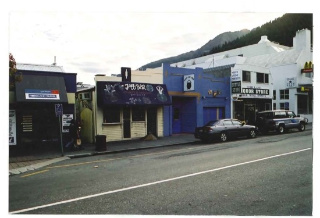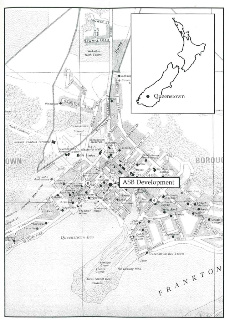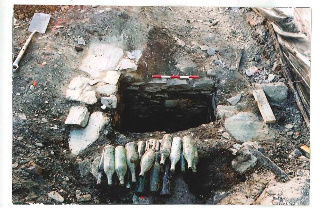ASB Site 24 Camp St, Queenstown
Contents
Timeline of Site Relevant to Archaeological Findings
1865: Occupied by C. Bond
1866: Described as Bakehouse, owned by Chs. Bond
1868-69: occupied by Eichardt
1869: Described as a Ginger Beer Factory
1870: purchased by D. Lyall
1876-1921: Owned by Fred Finch, contained house and shops
1921-1924: Property administered by the Public Trust for Finch’s estate
1924: Purchased by Alfred Mayne Jr.
1928: Title Transferred to Winifred Nellie Scott
1954: Sold to Marshall Campbell
Site Excavation
ASB Site 24 Camp St, Queenstown was excavated under archaeological Authority 2001/123. Four trenches were excavated containing artifacts from the 19th and 20th centuries.
Rear South Trench
Features: 1 (small circular pit) and 2 (a square schist lined pit)
Artifacts: glassware, ceramics, clock parts, and chamber pot [1]
[5]
East Trench
Features: 3 (Rubbish pit), 4 and 5 (two rubbish concentrations), and 6 (a buried sump)
Artifacts: glassware, gasmeter, shoes, sheet iron container
[6]
West Trench
Features: 7 (sump lined with thin sheet iron.
Artifacts: bottles, glass jars,
[7]
Sewer Trench
The sewer trench was excavated to a depth of 0.63m. The sewer line was salt glazed earthen ware and had recent additions in red ceramic with rubber seals. Post dates the archaeological features on the site.
Artifacts: fragments of ceramics, glass, and bone.
[8]
Features
Feature 1
A small rubbish pit in the Rear Trench is roughly oval in shape, measuring 0.6m by 0.4m and was 0.4m deep. Mainly contained bottles and bottle glass, but also included sections of a stoneware crock and parts of several clocks.
Glassware [2] McGavin & Co. Ltd. Crown top beer bottle (post dates 1923), Two oval section green whisky bottles (early 20th century date), A Symington & Co. Essence of Coffee and Chicory bottle, A Johnnie Walker Whiskey bottle, A Bols Dry Gin bottle, a Brooke’s Fruit Squash bottle, six broken bottle necks, eleven broken bottle bases and a small intact green crown top bottle.
Ceramics The ceramic material in feature 1 was an intact stoneware blacking bottle, a white earthenware plate fragment and several fragments of a large (6 quart) stoneware crock.
Other In addition to glassware and stoneware there were a few clock parts which appeared to be mainly from alarm clocks or cheap mantle clocks
Discussion The dating of the materials found in feature one is early 20th century. It was noted as a small rubbish pit filled in a short period of time. The inclusion of clock parts in the material artifacts suggests that this may have been a clock shop at one time. [9]
Feature 2
A schist lined pit measuring 1m. x 1m. x 1m. The walls of the pit were dry-laid schist slabs while the floor was simply gravel. The original purpose of the pit is unknown. May have been a privy. Its final use was as a rubbish pit.
Top Half of Pit This half was largely filled with broken fancy glass and chinese opium tins.
Lower Half of Pit This half was largely filled with 19th century rubbish ( alcohol bottles and ceramics). Also found in this half was a bone tube, with a screw-in end, containing a child's marble.
Opium Containers The opium tins were recovered exclusively from the upper half of the pit. 118 lids and bases were found. Each tin held 186.5 grams of opium.
Glassware Glassware from the top half was all extremely fragmented containing much ornate pressed and cut glass, and many drinking glasses both tumblers and stemmed. Glassware from the lower half included 23 complete bottles including 13 wine/spirit bottles, 2 ring-seal beer bottles, 3 black beer/whisky bottles, 2 "skittle" bottles, a Davis Vegetable Painkiller bottle and two small pharmaceutical/essence bottles.
Ceramics From the top half came a 3/4 intact ceramic chamber pot and a half Rouen pattern plate as well as a clay pipe that contained some burnt tobacco. The pipe was intact although the stem had been broken off. The pipe was stamped "60 DAVIDSON" on one side of the stem, and "GLASSGOW" on the other. Dates 1863-1910
Bone Tube
The tube measured 78 mm long, 26 mm in outside diameter, and 21 mm in inside diameter. Its use or purpose is unknown.
Discussion This feature may have started life as a stone lined privy but was later used as a rubbish pit, initially containing a fairly typical rubbish assemblage. [10]
Feature 3
Feature 3 was a rubbish pit located close to the eastern side of the section measuring 1 m x 0.75m.
Artifacts
This feature contained an old cast iron cistern, a brass oil lamp, a cast iron kettle, a large serving spoon and a gas meter. It appears to have been a pit dug to dispose of a number of specific items, as it did not contain any moregeneral fubbish. The age of the pit was difficult to determine.
Discussion
Feature 3 contained mainly heavy domestic items, with no smaller material such as broken crockery or bottle glass. It appears to have been a specifically dug pit to dispose of a number of large unwanted objects. [11]
Conclusion
Archaeological investigation of the ASB yielded a mixture of features and artifacts of various dates. Undisturbed material was found in deeper pit features, that had escaped the surface disturbance created during various building and modification episodes. The available historical information regarding the site does not immediately explain the assemblage. [12]
References
- ↑ Petchy, P.G. ASB Site 24 Camp St., Queenstown Report on Archaeological Investigations, 2001 (2-4).
- ↑ ibid (xi).
- ↑ ibid (x).
- ↑ Petchy, P.G. ASB Site 24 Camp St., Queenstown Report on Archaeological Investigations, 2001 (1-20).
- ↑ ibid (6-7).
- ↑ ibid (8).
- ↑ ibid (9).
- ↑ ibid (9).
- ↑ ibid (10-11).
- ↑ ibid (12-16).
- ↑ ibid (17-18).
- ↑ ibid (19-20).



